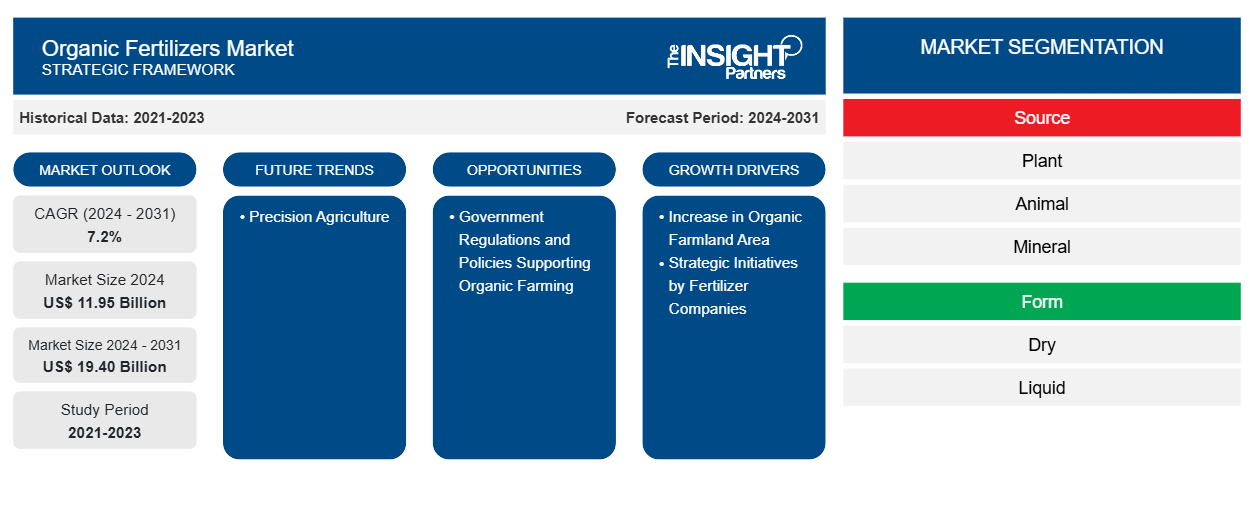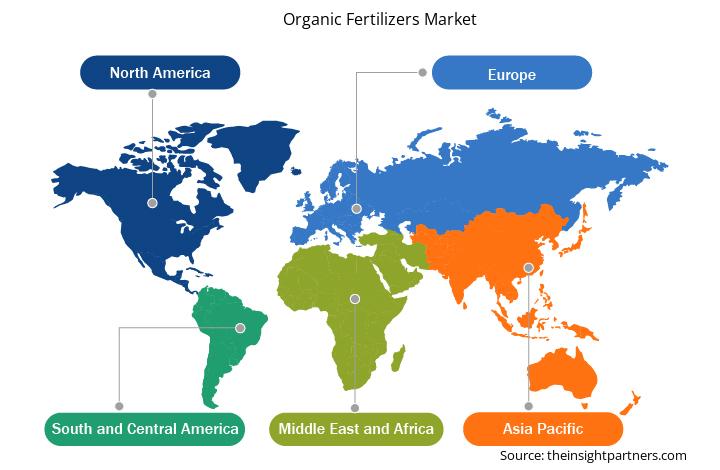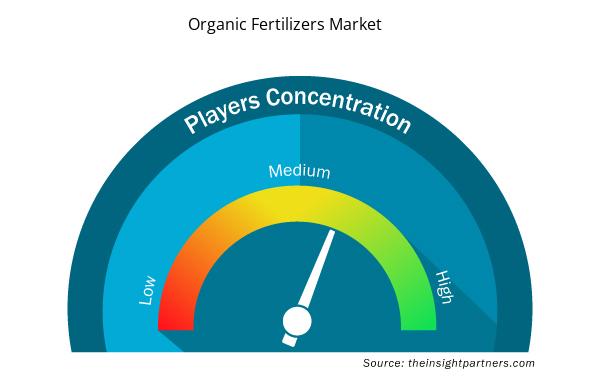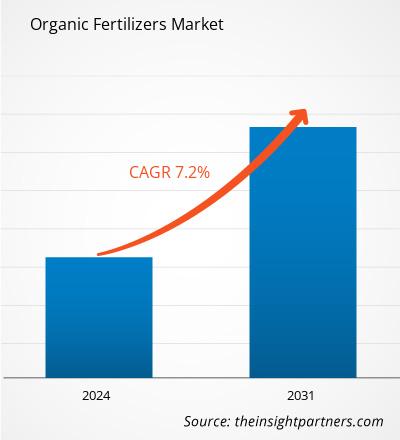Si prevede che la dimensione del mercato dei fertilizzanti organici raggiungerà i 19,40 miliardi di dollari entro il 2031, rispetto agli 11,95 miliardi di dollari del 2024. Si prevede che il mercato registrerà un CAGR del 7,2% nel periodo 2024-2031. Si prevede che l'adozione dell'agricoltura di precisione porterà nuove tendenze di crescita nel mercato dei fertilizzanti organici, creando potenziali affari durante il periodo di previsione.
Analisi del mercato dei fertilizzanti organici
Man mano che i materiali organici si decompongono, rilasciano gradualmente nutrienti, fornendo un apporto lento ma costante di nutrimento alle piante. Ciò contrasta con i fertilizzanti sintetici, che spesso forniscono rapidamente nutrienti ma possono portare a squilibri nutrizionali, acidificazione del suolo e impoverimento a lungo termine della materia organica del suolo. Inoltre, i fertilizzanti organici aumentano l'attività microbica nel suolo, favorendo un ecosistema diversificato ed equilibrato che supporta il ciclo dei nutrienti, la salute delle piante e la resistenza a parassiti e malattie. Sebbene i fertilizzanti organici siano altamente benefici, presentano alcune limitazioni. In genere forniscono concentrazioni di nutrienti inferiori rispetto ai fertilizzanti sintetici, il che significa che potrebbero essere necessarie quantità maggiori per ottenere gli stessi risultati. Il contenuto di nutrienti dei fertilizzanti organici può variare a seconda della fonte e del metodo di lavorazione, rendendo più difficile prevedere il profilo nutrizionale esatto. Nonostante queste sfide, la popolarità dei fertilizzanti organici è in aumento, in particolare tra giardinieri, agricoltori biologici e personale che si concentra sull'agricoltura sostenibile. Agricoltori e giardinieri possono ridurre il loro impatto ambientale utilizzando fertilizzanti organici, sostenere la biodiversità e creare ecosistemi più sani e resilienti. Nel complesso, i fertilizzanti organici sono fondamentali per mantenere la fertilità del suolo a lungo termine e promuovere la salute delle piante e dell'ambiente.
Panoramica del mercato dei fertilizzanti organici
I fertilizzanti organici sono derivati naturalmente da fonti vegetali, animali e minerali che forniscono nutrienti essenziali alle piante. I fertilizzanti organici migliorano la fertilità del suolo e promuovono pratiche agricole sostenibili migliorando la struttura del suolo e supportando microrganismi benefici. Sono generalmente considerati rispettosi dell'ambiente, in quanto sono biodegradabili e riducono il rischio di contaminazione dell'acqua e degradazione del suolo. I fertilizzanti organici sono ricchi di macronutrienti (azoto, fosforo, potassio, ecc.) e micronutrienti (calcio, magnesio, zolfo, ecc.), tutti essenziali per una sana crescita delle piante. I fertilizzanti di origine animale costituiscono uno dei tipi più comuni di fertilizzanti organici; questi includono letame compostato di mucche, polli o cavalli. I fertilizzanti organici di origine animale sono ricchi di azoto e materia organica, che migliorano la consistenza del suolo, la ritenzione idrica e l'attività microbica. D'altro canto, i fertilizzanti di origine vegetale sono prodotti da materiali vegetali come alghe, farina di erba medica o residui di colture compostate.
Personalizza questo report in base alle tue esigenze
Riceverai la personalizzazione gratuita di qualsiasi report, comprese parti di questo report, o analisi a livello nazionale, pacchetto dati Excel, oltre a usufruire di grandi offerte e sconti per start-up e università
Mercato dei fertilizzanti organici: approfondimenti strategici

- Scopri le principali tendenze di mercato in questo rapporto.Questo campione GRATUITO includerà analisi di dati che spaziano dalle tendenze di mercato alle stime e alle previsioni.
Driver e opportunità del mercato dei fertilizzanti organici
Le iniziative strategiche delle aziende produttrici di fertilizzanti rafforzano la crescita del mercato
Le principali aziende del mercato generale dei fertilizzanti stanno implementando iniziative strategiche per espandere la loro presenza sul mercato, migliorare la sostenibilità delle colture e soddisfare le crescenti richieste dei consumatori. Queste iniziative si concentrano su miglioramenti della catena di fornitura, progressi tecnologici, programmi di certificazione, partnership e investimenti in ricerca e sviluppo. I produttori di alimenti biologici, i rivenditori, le aziende agroalimentari, ecc. svolgono un ruolo cruciale nel plasmare l'ecosistema dell'agricoltura biologica. Le aziende di fertilizzanti biologici stanno investendo nella ricerca agricola e nella biotecnologia per affrontare le sfide associate all'agricoltura biologica, tra cui bassa resa e crescita di parassiti. Ad esempio, Bayer AG e Syngenta, due noti produttori di fertilizzanti sintetici, stanno esplorando fertilizzanti biologici e soluzioni per la salute del suolo. A marzo 2023, Windfall Bio ha raccolto 9 milioni di dollari in finanziamenti iniziali per lanciare una soluzione di fertilizzante da metano a organico. L'azienda ha pianificato di sviluppare la prima soluzione in assoluto per catturare e trasformare le emissioni di metano in fertilizzanti organici viventi.
Regolamenti e politiche governative a sostegno dell'agricoltura biologica per creare opportunità di crescita
I governi stanno implementando normative e politiche per promuovere l'agricoltura biologica come parte delle loro strategie più ampie di sostenibilità e sicurezza alimentare. Queste politiche si concentrano su incentivi finanziari, standard di certificazione e supporto alla ricerca per aiutare nello sviluppo generale del mercato e incoraggiare la transizione dall'agricoltura convenzionale a quella biologica. Quasi tutti gli stati membri dell'UE supportano l'agricoltura biologica attraverso una definizione legale a livello UE, pagamenti per la conversione e il mantenimento agroambientali, sovvenzioni per la commercializzazione e la trasformazione dello sviluppo rurale, iniziative di finanziamento della promozione e appalti pubblici, nonché iniziative di ricerca e informazione. Nel 2020, la Commissione europea ha introdotto la strategia Farm to Fork, che ha definito una serie di obiettivi per migliorare la sostenibilità nella produzione alimentare nell'UE. Questi obiettivi includono una riduzione del 50% nell'uso di pesticidi e una diminuzione del 20% nell'uso di fertilizzanti; mira inoltre ad aumentare la quota di agricoltura biologica al 25% del totale dei terreni agricoli. Nel 2022, il Dipartimento dell'agricoltura degli Stati Uniti ha lanciato l'Organic Transition Initiative con un investimento di 300 milioni di dollari, che offre una serie di programmi e risorse per aiutare gli agricoltori biologici esistenti e coloro che stanno passando alla produzione e alla trasformazione biologica negli Stati Uniti.
Analisi della segmentazione del rapporto di mercato sui fertilizzanti organici
I segmenti chiave che hanno contribuito alla derivazione dell'analisi di mercato dei fertilizzanti organici sono la fonte, la forma e il tipo di coltura.
- In base alla fonte, il mercato dei fertilizzanti organici è segmentato in piante, animali e minerali. Il segmento delle piante deteneva la quota maggiore del mercato nel 2024.
- In base alla forma, il mercato è diviso in secco e liquido. Il segmento secco ha dominato il mercato nel 2024.
- In base al tipo di coltura, il mercato è segmentato in frutta e verdura, cereali e granaglie, tappeti erbosi e ornamentali, fiori e vivai, colture arboree, legumi, erbe e spezie, semi oleosi, tuberi e radici e altri. Il segmento dei semi oleosi ha detenuto la quota di mercato maggiore nel 2024.
Analisi della quota di mercato dei fertilizzanti organici per area geografica
L'ambito geografico del rapporto sul mercato dei fertilizzanti organici è suddiviso in cinque regioni: Nord America, Asia Pacifico, Europa, Medio Oriente e Africa e Sud e Centro America. Si prevede che il mercato dei fertilizzanti organici nell'Asia Pacifico crescerà in modo significativo durante il periodo di previsione.
Tra i paesi dell'Asia Pacifica, l'Australia presenta una domanda significativa di fertilizzanti organici, che può essere associata all'aumento dell'area agricola biologica. Secondo IFOAM - Organics International, l'Australia è diventata il paese con la più grande area agricola biologica al mondo, poiché l'area sottoposta ad agricoltura biologica è aumentata di 17,3 milioni di ettari nel 2022 rispetto al 2021, raggiungendo un totale di 53 milioni di ettari nel 2022. Il paese si concentra sull'agricoltura sostenibile, supportata da politiche e iniziative governative. Ad esempio, il governo australiano ha istituito il Climate-Smart Agriculture Program nel 2023-2024, che si estende su un periodo di cinque anni con un investimento di 185,38 milioni di dollari. Il programma mira a supportare la sostenibilità agricola, la produttività e la competitività. Pertanto, il forte settore dell'agricoltura biologica e le iniziative governative di supporto stimolano la crescita del mercato dei fertilizzanti organici nel paese.
Approfondimenti regionali sul mercato dei fertilizzanti organici
Le tendenze regionali e i fattori che influenzano il mercato dei fertilizzanti organici durante il periodo di previsione sono stati ampiamente spiegati dagli analisti di Insight Partners. Questa sezione discute anche i segmenti e la geografia del mercato dei fertilizzanti organici in Nord America, Europa, Asia Pacifico, Medio Oriente e Africa e Sud e Centro America.

- Ottieni i dati specifici regionali per il mercato dei fertilizzanti organici
Ambito del rapporto sul mercato dei fertilizzanti organici
| Attributo del report | Dettagli |
|---|---|
| Dimensioni del mercato nel 2024 | 11,95 miliardi di dollari USA |
| Dimensioni del mercato entro il 2031 | 19,40 miliardi di dollari USA |
| CAGR globale (2024 - 2031) | 7,2% |
| Dati storici | 2021-2023 |
| Periodo di previsione | 2024-2031 |
| Segmenti coperti | Per fonte
|
| Regioni e Paesi coperti | America del Nord
|
| Leader di mercato e profili aziendali chiave |
|
Densità degli attori del mercato dei fertilizzanti organici: comprendere il suo impatto sulle dinamiche aziendali
Il mercato dei fertilizzanti organici sta crescendo rapidamente, spinto dalla crescente domanda degli utenti finali dovuta a fattori quali l'evoluzione delle preferenze dei consumatori, i progressi tecnologici e una maggiore consapevolezza dei benefici del prodotto. Con l'aumento della domanda, le aziende stanno ampliando le loro offerte, innovando per soddisfare le esigenze dei consumatori e capitalizzando sulle tendenze emergenti, il che alimenta ulteriormente la crescita del mercato.
La densità degli operatori di mercato si riferisce alla distribuzione di aziende o società che operano in un particolare mercato o settore. Indica quanti concorrenti (operatori di mercato) sono presenti in un dato spazio di mercato in relazione alle sue dimensioni o al valore di mercato totale.
Le principali aziende che operano nel mercato dei fertilizzanti organici sono:
- Agrocare Canada
- Biostar Rinnovabili LLC
- Coromandel International Limited
- Italpolina SPA
- BioAg del Midwest
- Krishak Bharati cooperativa limitata
Disclaimer : le aziende elencate sopra non sono classificate secondo un ordine particolare.

- Ottieni una panoramica dei principali attori del mercato dei fertilizzanti organici
Notizie e sviluppi recenti sul mercato dei fertilizzanti organici
Il mercato dei fertilizzanti organici viene valutato raccogliendo dati qualitativi e quantitativi post-ricerca primaria e secondaria, che includono importanti pubblicazioni aziendali, dati associativi e database. Alcuni degli sviluppi chiave nel mercato dei fertilizzanti organici sono i seguenti:
- Nel dicembre 2024, Coromandel International Limited (il principale fornitore di soluzioni agricole in India) e Krish-e [settore verticale di attività del settore delle attrezzature agricole (FES) di Mahindra & Mahindra Limited] hanno annunciato una partnership per estendere i servizi di irrorazione tramite droni di Coromandel, Gromor Drive, agli agricoltori indiani. (Fonte: Coromandel International Limited, sito Web aziendale, dicembre 2024)
- The Andersons, Inc. ha finalizzato l'acquisizione di una quota di maggioranza in Skyland Grain, LLC. La transazione consente a The Andersons di espandere le sue attività principali di cereali e fertilizzanti in mercati strategici, tra cui Kansas, Oklahoma, Colorado e Texas. (Fonte: The Andersons, Inc., comunicato stampa, novembre 2024)
Copertura e risultati del rapporto sul mercato dei fertilizzanti organici
Il rapporto "Dimensioni e previsioni del mercato dei fertilizzanti organici (2021-2031)" fornisce un'analisi dettagliata del mercato che copre le seguenti aree:
- Dimensioni e previsioni del mercato dei fertilizzanti organici a livello globale, regionale e nazionale per tutti i principali segmenti di mercato coperti dall'ambito
- Tendenze del mercato dei fertilizzanti organici, nonché dinamiche di mercato quali driver, vincoli e opportunità chiave
- Analisi dettagliata delle cinque forze di Porter e SWOT
- Analisi del mercato dei fertilizzanti organici che copre le principali tendenze del mercato, il quadro globale e regionale, i principali attori, le normative e i recenti sviluppi del mercato
- Analisi del panorama industriale e della concorrenza che copre la concentrazione del mercato, l'analisi della mappa di calore, i principali attori e gli sviluppi recenti per il mercato dei fertilizzanti organici
- Profili aziendali dettagliati
- Analisi storica (2 anni), anno base, previsione (7 anni) con CAGR
- Analisi PEST e SWOT
- Valore/volume delle dimensioni del mercato - Globale, regionale, nazionale
- Industria e panorama competitivo
- Set di dati Excel



Report Coverage
Revenue forecast, Company Analysis, Industry landscape, Growth factors, and Trends

Segment Covered
This text is related
to segments covered.

Regional Scope
North America, Europe, Asia Pacific, Middle East & Africa, South & Central America

Country Scope
This text is related
to country scope.
Domande frequenti
Asia Pacific dominated the market with the largest share in 2024.
Increasing organic farmland areas and strategic development initiatives by key market players are major factors contributing to market growth.
The introduction of new farming technologies such as precision agriculture is likely to bring key trends in the market in the future.
AgroCare Canada, Inc; Coromandel International Ltd; Hello Nature International Srl; Midwestern BioAg; Krishak Bharati Cooperative Limited (KRIBHCO); The Scotts Miracle-Gro Co; Indian Farmers Fertiliser Cooperative Ltd (IFFCO); Shriansh Dharti Fertilizer (SDF) India Private Limited.; Ferticell; Espoma; Down To Earth; Yara International ASA; Suståne Natural Fertilizer, Inc; Darling Ingredients Inc; and The Andersons Inc are among the key players operating in the market.
The market size is projected to reach US$ 19.40 billion by 2031.
Trends and growth analysis reports related to Chemicals and Materials : READ MORE..
The List of Companies - Organic Fertilizers Market
- AgroCare Canada, Inc
- Coromandel International Ltd
- Midwestern BioAg
- Krishak Bharati Cooperative Limited (KRIBHCO)
- The Scotts Miracle-Gro Co
- Indian Farmers Fertiliser Cooperative Ltd (IFFCO)
- Shriansh Dharti Fertilizer (SDF) India Private Limited.
- Yara International ASA
- Darling Ingredients Inc
- The Andersons Inc
The Insight Partners performs research in 4 major stages: Data Collection & Secondary Research, Primary Research, Data Analysis and Data Triangulation & Final Review.
- Data Collection and Secondary Research:
As a market research and consulting firm operating from a decade, we have published and advised several client across the globe. First step for any study will start with an assessment of currently available data and insights from existing reports. Further, historical and current market information is collected from Investor Presentations, Annual Reports, SEC Filings, etc., and other information related to company’s performance and market positioning are gathered from Paid Databases (Factiva, Hoovers, and Reuters) and various other publications available in public domain.
Several associations trade associates, technical forums, institutes, societies and organization are accessed to gain technical as well as market related insights through their publications such as research papers, blogs and press releases related to the studies are referred to get cues about the market. Further, white papers, journals, magazines, and other news articles published in last 3 years are scrutinized and analyzed to understand the current market trends.
- Primary Research:
The primarily interview analysis comprise of data obtained from industry participants interview and answers to survey questions gathered by in-house primary team.
For primary research, interviews are conducted with industry experts/CEOs/Marketing Managers/VPs/Subject Matter Experts from both demand and supply side to get a 360-degree view of the market. The primary team conducts several interviews based on the complexity of the markets to understand the various market trends and dynamics which makes research more credible and precise.
A typical research interview fulfils the following functions:
- Provides first-hand information on the market size, market trends, growth trends, competitive landscape, and outlook
- Validates and strengthens in-house secondary research findings
- Develops the analysis team’s expertise and market understanding
Primary research involves email interactions and telephone interviews for each market, category, segment, and sub-segment across geographies. The participants who typically take part in such a process include, but are not limited to:
- Industry participants: VPs, business development managers, market intelligence managers and national sales managers
- Outside experts: Valuation experts, research analysts and key opinion leaders specializing in the electronics and semiconductor industry.
Below is the breakup of our primary respondents by company, designation, and region:

Once we receive the confirmation from primary research sources or primary respondents, we finalize the base year market estimation and forecast the data as per the macroeconomic and microeconomic factors assessed during data collection.
- Data Analysis:
Once data is validated through both secondary as well as primary respondents, we finalize the market estimations by hypothesis formulation and factor analysis at regional and country level.
- Macro-Economic Factor Analysis:
We analyse macroeconomic indicators such the gross domestic product (GDP), increase in the demand for goods and services across industries, technological advancement, regional economic growth, governmental policies, the influence of COVID-19, PEST analysis, and other aspects. This analysis aids in setting benchmarks for various nations/regions and approximating market splits. Additionally, the general trend of the aforementioned components aid in determining the market's development possibilities.
- Country Level Data:
Various factors that are especially aligned to the country are taken into account to determine the market size for a certain area and country, including the presence of vendors, such as headquarters and offices, the country's GDP, demand patterns, and industry growth. To comprehend the market dynamics for the nation, a number of growth variables, inhibitors, application areas, and current market trends are researched. The aforementioned elements aid in determining the country's overall market's growth potential.
- Company Profile:
The “Table of Contents” is formulated by listing and analyzing more than 25 - 30 companies operating in the market ecosystem across geographies. However, we profile only 10 companies as a standard practice in our syndicate reports. These 10 companies comprise leading, emerging, and regional players. Nonetheless, our analysis is not restricted to the 10 listed companies, we also analyze other companies present in the market to develop a holistic view and understand the prevailing trends. The “Company Profiles” section in the report covers key facts, business description, products & services, financial information, SWOT analysis, and key developments. The financial information presented is extracted from the annual reports and official documents of the publicly listed companies. Upon collecting the information for the sections of respective companies, we verify them via various primary sources and then compile the data in respective company profiles. The company level information helps us in deriving the base number as well as in forecasting the market size.
- Developing Base Number:
Aggregation of sales statistics (2020-2022) and macro-economic factor, and other secondary and primary research insights are utilized to arrive at base number and related market shares for 2022. The data gaps are identified in this step and relevant market data is analyzed, collected from paid primary interviews or databases. On finalizing the base year market size, forecasts are developed on the basis of macro-economic, industry and market growth factors and company level analysis.
- Data Triangulation and Final Review:
The market findings and base year market size calculations are validated from supply as well as demand side. Demand side validations are based on macro-economic factor analysis and benchmarks for respective regions and countries. In case of supply side validations, revenues of major companies are estimated (in case not available) based on industry benchmark, approximate number of employees, product portfolio, and primary interviews revenues are gathered. Further revenue from target product/service segment is assessed to avoid overshooting of market statistics. In case of heavy deviations between supply and demand side values, all thes steps are repeated to achieve synchronization.
We follow an iterative model, wherein we share our research findings with Subject Matter Experts (SME’s) and Key Opinion Leaders (KOLs) until consensus view of the market is not formulated – this model negates any drastic deviation in the opinions of experts. Only validated and universally acceptable research findings are quoted in our reports.
We have important check points that we use to validate our research findings – which we call – data triangulation, where we validate the information, we generate from secondary sources with primary interviews and then we re-validate with our internal data bases and Subject matter experts. This comprehensive model enables us to deliver high quality, reliable data in shortest possible time.

 Ottieni un campione gratuito per questo repot
Ottieni un campione gratuito per questo repot